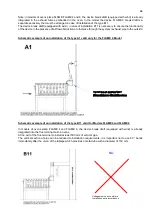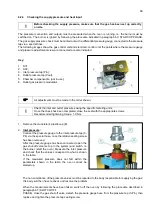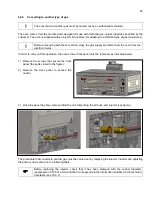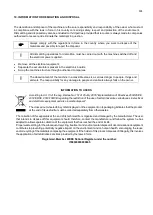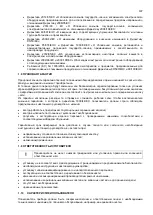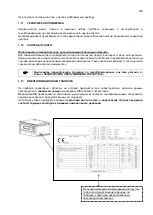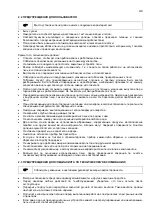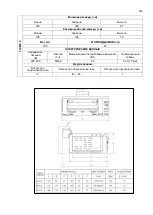
97
7.2 SWITCHING ON THE OVEN FOR THE FIRST TIME
!
FOR A GOOD STARTUP OF THE OVEN, KEEP THE DOOR OPEN UNTIL THE
THERMOMETER DOESN'T SHOWING 200° C
When the equipment is used for the first time, it is advisable to heat the oven when empty to eliminate bad
smells caused by the evaporation of the refractory stones and the inner metallic parts.
Procedure:
T
urn the main switch to “1” after checking
that the oven is connected to the electric power supply;
Let the (empty) oven operate for at least 8 hours at a temperature of 300°-350° before proceeding with the
first batch.
7.3 START-UP PHASE
!
FOR A GOOD STARTUP OF THE OVEN, KEEP THE DOOR OPEN UNTIL THE
THERMOMETER DOESN'T SHOWING 200° C
After connecting the oven to the electrical mains turn the main switch (A) to “1”. The digital thermometer display
will show the average real temperature of the cooking chamber. At this point, turn the thermostat knob (D) to
the desired temperature. This will start the oven, that is, the gas is ignited and the flame is produced.
If no baking is being carried out, but you simply want to maintain the oven at temperature, leave the switch (B)
in position 0 (min), which minimises gas consumption. If you want to start baking and therefore start the
subsequent batches, turn the switch (B) to 1 (max), and keep this setting for the entire baking period.
7.4 GENERAL COOKING INSTRUCTIONS
Generally for the food products it is not possible to provide precise temperature and baking times because of
their different characteristics.
Particularly, regarding pizza and similar products, time and temperatures depend on the shape and thickness
of the dough, as well as the quantity and type of the additional ingredients.
For these reasons it is always advisable to initially carry out some baking tests,
(particularly when this
oven model is used for the first time), in order to better understand its characteristics and operation.
7.5 PIZZA MAKER TIPS
This chapter contains ideas and advice coming from a team of skilled pizza chefs who continuously collaborate
in the development of our products.
For an optimal result, and therefore a good pizza, baking must be carried out at an average temperature of
380°C for approx. 3 ÷ 3.5 minutes.
For easier oven use and care, for the best result, we strongly advise to proceed as follows:
1) The oven must be on (heating phase) for at least 30/40 minutes before using it and during this phase it must
be set to the temperature desired for baking (approx. 380° is recommended)
2) At this stage proceed with the first batch keeping these settings
3) After baking the first pizzas (first batch) check the obtained result and if necessary further adjust the
temperature settings
4) Proceed with the second and then with the subsequent batches, keeping these settings.
5) Once several batches are done, or in any case while the oven must simply remain in temperature (without
any baking), turn the switch (B) to “0”. The oven
will remain in standby until the switch (B) is returned to position
“1”
(before starting to bake again).
For an optimal result, it is necessary that 20% of the baking surface (refractory stones) remains
free. This solution allows the best elimination of the water vapours released by the pizzas when
baking.
Summary of Contents for CHFPG4
Page 2: ...2...
Page 14: ...14 3 3 Schemi elettrici...
Page 15: ...15...
Page 47: ...47 3 3 Sch mas de c blage...
Page 48: ...48...
Page 80: ...80 3 3 Wiring diagrams...
Page 81: ...81...
Page 102: ...102 RU Category II2H3 Type of installation FLAME4 A1 B11 B21 FLAME 6 9 B11 B21...
Page 104: ...104 7 6 131 7 7 132 8 132 8 1 132 8 2 132 8 2 1 132 8 2 2 132 8 3 132 9 133 10 134...
Page 105: ...105 1 1 1 m 1 2 m 1 3 1 4...
Page 108: ...108 1 11 1 12 1 13 CE CE...
Page 109: ...109 RU 1 14 2 2 1...
Page 110: ...110 2 2 2 3...
Page 112: ...112 FLAME 9 148 126 47 105 105 15 196 18 220 230 50 60 50 3 x 0 75 2 B11 B21 I...
Page 113: ...113 3 3...
Page 114: ...114...
Page 116: ...116 4 25 50 50 m 5 5 1...
Page 117: ...117 5 2 25 50 50 6 6 1 4 2 F 6 2 6 2 1 3...
Page 118: ...118 6 2 1 1 6 2 2 1 13 1 5 6 2 3 A1 B11...
Page 119: ...119 B21 FLAME 4 FLAME 6 FLAME 9 B11 B11 A1 FLAME 4...
Page 123: ...123 FLAME 4 FLAME 6 45 6 2 4 6 3 1 EV1 2 EV2 3 Pin 4 Pout 5 6...
Page 124: ...124 1 0 1 E 2 3 Pin 6 7 3 Pin 3 4 Pout 4 B MAX 10 5 B MIN C D 6x1 E...
Page 130: ...130 A B C D E F G H 7 2 200 C 1 8 300 350 C 7 3 200 C A 1 D B 0 B 1 7 4...
Page 131: ...131 7 5 380 C 3 3 5 1 30 40 380 2 3 4 5 B 0 B 1 20 7 6 H 1...
Page 132: ...132 7 7 D 0 A 0 8 8 1 89 391 8 2 8 2 1 350 60 100 C 8 2 2 8 3...
Page 133: ...133 9 0 1 1 PF Schuko...
Page 134: ...134 10 13 151 25 2005 2002 95 2002 96 2003 108...
Page 146: ...146 3 3 Esquemas el ctricos...
Page 147: ...147...
Page 179: ...179 3 3 Schaltpl ne...
Page 180: ...180...
Page 201: ...201 EXPLODED VIEW DRAWINGS AND SPARE PARTS...
Page 202: ...202...
Page 203: ...203...
Page 209: ...209 ROTATING DOOR SYSTEM LAMP SYSTEM...
Page 210: ...210 ANALOGUE THERMOMETER CONTROLS DIGITAL THERMOMETER CONTROLS...
Page 211: ...211...




